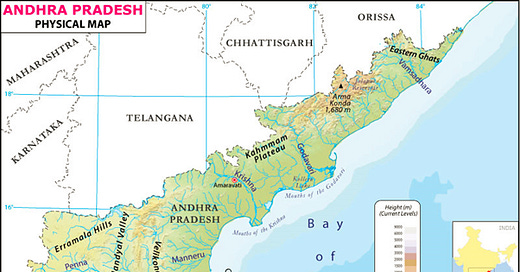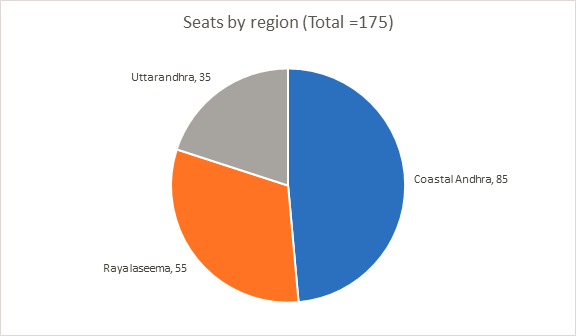The title derives inspiration from the ISRO launch station at Sriharikota, Andhra Pradesh
Background
Welcome to the next election season of 2024. Aside from the highly anticipated general elections in April and May of this year, eight states are slated to vote in 2024, four in each half of the year. Andhra Pradesh, Arunachal Pradesh, Odisha, and Sikkim will vote in the first half of 2024, followed by Haryana, Jammu & Kashmir, Maharashtra, and Jharkhand in the second half of the year. My poll coverage for the year begins with Andhra Pradesh, the largest poll-bound state in the first half of 2024. Before diving into politics, let us first examine the state's topography and its political ramifications.
Topography
Andhra Pradesh's landscape is dominated by its extensive coastline and the Krishna, Godavari, and Penna river basins. The state's lengthy coastline has resulted in excellent fish and shrimp output1, as well as the possibility for coastal shipping. Agriculture has long been the dominant industry in the fertile river plains, accounting for 40% of the state's economy and employing 60% of its workers. Furthermore, the discovery of natural gas deposits in the Krishna-Godavari basin holds promise, although production has practically halved from its peak of 1.4 million cubic metres per day in 2011. The Eastern Ghats, which are fragmented, separate the coastal plains from the peneplains2 in the hinterlands. The state's non-coastal areas are rich in minerals such as granite (India's top producer) and limestone (India's third largest producer). The state is India's second largest cement manufacturer due to its extensive limestone reserves. Access to water, and thus agricultural productivity is the defining division of the state. The coastal areas benefit from the river waters and annual rainfall of between 1000-1200 mm, while the hinterland has less access to river water and annual rainfall of 500-700 mm. This leads to the two divisions: coastal Andhra (Kostandhra) and non-coastal Andhra (Rayalseema). With this geographical perspective, let us now consider the state's history.
History
I have previously covered large parts of the history of Andhra Pradesh in my coverage on Telangana, and therefore will stick to the most politically relevant aspects here. The Vijayanagara Empire controlled almost all of modern-day Andhra Pradesh. With the empire's decline, certain areas of Andhra fell under the jurisdiction of the British or the Nizam of Hyderabad (see map below). Following the Carnatic Wars in the seventeenth century, British influence spread over South Coastal Andhra Pradesh. The Nizam of Hyderabad handed North Coastal Andhra Pradesh to the British in 1759, and Rayalaseema in 1796.
Even while all portions of Andhra Pradesh have a shared language and cultural legacy, the relative differential in economic growth caused by geography (coastal vs. hinterland) and/or time of accession has resulted in three main political regions, which we will discuss next.
Political Divisions
The map of Andhra Pradesh below is divided into three major regions: Uttarandhra, Coastal Andhra, and Rayalaseema, as depicted below.
The Uttarandhra region is a relatively modern construct resulting from relative underdevelopment that has gained some traction, particularly following the creation of Telangana. Rayalaseema is also a relatively recent phrase. The region was referred to as the ceded districts, but this was considered pejorative, therefore Chilukuri Narayana Rao (a lecturer and activist) invented the word Rayalaseema, which was accepted by the Andhra Mahasabha in 1928. Coastal Andhra is the most politically important of the three areas, accounting for roughly half of the Vidhan Sabha constituencies. (See chart below)
Electoral History
The INC controlled Andhra Pradesh politics from its inception in 1953 until 1983, when the Telugu Desam Party (TDP), led by the charismatic N.T. Rama Rao, rose to power. NTR, as he is known, dominated state politics from 1982, when he founded the TDP, until his death in 1996. During his three stints in office (1983-85, 1985-89, and 1991-95), Telugu identity and pride in politics rose to prominence, backward castes were politically empowered, and land tax and administration reforms were implemented. N. Chandrababu Naidu, NTR's son-in-law, conducted a family coup against him in 1995, seizing leadership of the TDP and guiding it to victory in 1999. This term paved the way for Hyderabad's eventual emergence as an investment destination. The INC experienced a rebirth throughout the next two electoral cycles (2004 and 2009), led by Y.S. Rajasekhara Reddy. The death of YSR in a helicopter crash in late 2009 caused a vertical split in the INC, with YSR's son Jagan Mohan Reddy hollowing out the party and forming the new YSRCP (Yuvajana Sramika Rythu Congress Party). The YSRCP lost the 2014 elections to the TDP despite winning 45.38% of the vote, but came to power in 2019 with a landslide victory (151/175 seats, 49.95% vote share). Even though Andhra politics has typically been polarised since 1983, the Praja Rajyam Party (PRAP), founded by film star Chiranjeevi, and the Jana Sena Party (JaS), founded by his brother and actor Pawan Kalyan, have managed to break the mould, polling 16.72% in 2009 and 5.53% in 2019.
Andhra Pradesh elections have consistently provided decisive mandates, as seen below:
Vote Share polled by top 2 party groups
All figures in %. Vote shares pertain to pre-poll alliances, as applicable
*- Figures refer to sub-divided Andhra Pradesh (Not including Telangana)
**- Refers to only YSRCP vote share
Having understood the political landscape, let us now look at the key players involved.
Key Political Players
AP is India’s largest fish and shrimp producer
Peneplains are a more or less level land surface produced by erosion over a long period, undisturbed by crustal movement.











